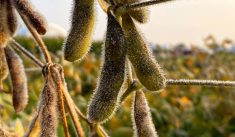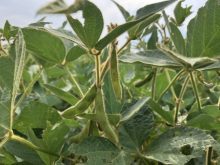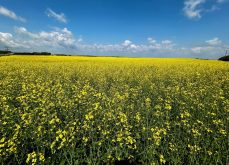Growing premium-priced, food-grade, non-genetically modified (GM) soybeans is a fit for some Manitoba farmers — but it’s not for everyone.
There are important factors to consider, says Dennis Lange, Manitoba Agriculture and Resource Development’s pulse crop specialist.
Non-GM soybeans grown under contract can earn a $1.50 to $2 a bushel premium over regular GM soybeans destined for the crush market.
In addition to premiums, non-GM soybeans, like their GM counterparts, provide other benefits including fixing nitrogen, providing farmers with another profitable crop option and extended rotations.
Read Also

Critical growing season is ahead for soybeans
What the weather turns out to be in the United States is going to have a significant impact on Canadian producers’ prices
However, because there are no non-selective herbicides to control weeds in non-GM soybeans, growing them can be more challenging.
“So there is a little bit more work involved, but again you really need to look at your own operation,” Lange said in an interview June 2.
Non-GM soybeans are mainly exported to Asia and consumed as noddles and tofu, so quality control is critical. That’s why Canadian buyers are contracting production directly with farmers and prescribing which varieties they grow.
Why it matters: Soybeans give Manitoba farmers another crop option. While farmers can earn a premium price from non-GM soybeans, growing them can also be more challenging.
One of the advantages of Roundup Ready soybeans is they are genetically modified to tolerate glyphosate, which when applied to the crop kills most weeds without injuring the soybeans.
“If you have some real problem weeds that some traditional herbicides don’t get you may want to keep that in mind as well because if you have a really weedy field sometimes going with conventional (soybeans) might not be the best for that particular field.” Lange said.
That’s why it’s important to plant non-GM soybeans in clean fields.
There are selective herbicides to control weeds in non-GM soybeans (see at bottom), but they could end up costing more than glyphosate.
However, farmers with some glyphosate-toleratant weeds such as kochia or volunteer canola face additional herbicide costs.
“So those (potential herbicide) costs are not as far apart as they once were,” Lange added.
“If you have some weed resistance issues it’s (growing non-GM soybeans) another way to kind of deal with it.”
Starting with a clean field is important when growing non-GM soybeans, says Eric McLean of JS Henry Seeds at Oak River.
“We’re seeing non-GMO has a fit for some guys — not everybody,” McLean said in an interview. “It does require more management and effort on the part of the producers to make sure the fields are adequately prepared and clean (from weeds) in the upcoming growing season to maximize the yield. Because they are non-GMO, the herbicide options are not as effective as GMO soybeans.”

Field preparation starts in the fall, McLean said. For example last fall he sprayed glyphosalte on an InVigor canola field intended for non-GM soybeans this spring.
“The field did stay nice and clean up until the application time of a herbicide (this spring),” he said. “We were able to get those seeds up and out of the ground.”
After seeding the non-GM soybeans this spring, McLean applied Authority for hard-to-control broadleaf weeds such as cleavers and kochia. Then he applied Phantom for grass- and broad-leaved weeds.
“We’re hoping the field can stay nice and clean until the crop is up and canopied a bit so (crop) competition takes effect to keep the yield up,” McLean said.
JS Henry Seeds works with Prograin, growing the specific varieties the company wants farmers to sow.
JS Henry Seeds also takes delivery of contracted crop in the fall, conditions it and loads it into containers exported to Asia. McLean said he shipped about 1,000 tonnes overseas of non-GM soybeans for Prograin last winter and this spring.
“We’re seeing an increase (in interest),” he said. “The market is fairly stable and increasing but not at a rapid rate as western (Manitoba total soybean) acres have gone down in the last couple of years.
“I think in general the market will continue to grow so long as guys get paid and have success with it. So far so good.”
Yield depends on the field and growing conditions, but non-GM soybeans probably produce 10 to 15 per cent less than GM varieties, but it’s offset by a higher price, McLean said.
“If you’re getting $10 to $12 (a bushel) for your soybeans and add another two bucks on top of that you’re getting a 15 to 20 per cent extra return potentially on these things,” he said. “That adds up.”
There are lots of new non-GM soybeans being tested in Manitoba with a range of appropriate maturities, Lange said.
“Yields are better than what we’ve seen in the past,” he added. “And the protein content and the overall flavour of the beans are taken into account. That’s why they are being so much more selective on some of these lines.”
In the early days of Manitoba soybean production, all varieties were non-GM. Back then some farmers pursued food markets but after they had grown the crop.
“I think it’s a better system (now with contracting),” he said. “Before with conventional soybeans you had to find your own market. If Ontario had a good crop, folks in Japan would just go to Ontario and they wouldn’t come here…”
Purity
Non-GM soybean growers need to avoid contamination from GM soybeans, Lange said.
“Contamination would spoil your market,” he said. “They do test for GMO because that market requires no GMO. It requires a bit more of a checklist.”
That means not seeding in fields that might have GM volunteers, and cleaning augers, belt conveyors, bins, seeders and combines.
Variety selection is important too if iron chlorosis is a potential problem. Some non-GM varieties are more tolerant than others.
“If your carbonates and salts are a bit higher in a field it might not be well suited, depending on the year, for conventional soybeans,” Lange said.
Lange estimates about one to two per cent of Manitoba’s soybean acres is seeded to non-GM varieties.
He thinks around 17,000 non-GM soybean acres were seeded last year. This year he thinks around 1.4 million acres of soybeans were planted in Manitoba and around 30,000 were non-GM varieties.
(Statistics Canada’s March 31 report estimated Manitoba farmers would sow 1.3 million acres of soybeans, up 17 per cent from 2020. It would be the most soybean acres planted since 2017.)
Expanding opportunities for soybean production in Manitoba, including food-grade varieties, is a top priority for Soy Canada’s new executive director Brian Innes.
Canada has a reputation for delivering world, food-grade soybeans, he said in an interview.
“And you don’t stay on top without effort,” he added. “As a sector we need to remain laser-focused on our competitive advantage there. That’s where I see a real role for Soy Canada to tell that story internationally and to ensure things are in place here in Canada to deliver on that world-leading business.”
Tips for growing non-GM soybeans
- Good plant stand establishment will aid in weed control through improved crop competition.
- Choosing a variety and seed lot with good germination and vigour will help to establish a strong plant stand that will help to compete with weeds.
- Target 140,000 to 160,000 plants per acre established.
- Plant between 200,000 to 210,000 seeds per acre in a solid-seed operation.
- Pay attention to germination and overall seed mortality.
- If you are planting row crop soybeans, I would recommend the same established plant stand but you may be able to drop your seeding rating based on your planting equipment to 180,000 to 190,000 seeds per acre.
- Keep two full growing seasons between herbicide-tolerant varieties and conventional soybeans to avoid the risk of GMO soybean contamination.
- Volunteer corn is also a contamination risk so avoid conventional beans on corn ground.
- Proper inoculation will help to supply the plant with the needed nitrogen for the growing season. This means using on-seed inoculant combined with a granular in-furrow inoculant on fields with a short history of soybeans.
Weed control
- To avoid accidental drift, let neighbours know you are growing non-GM soybeans
- Start with a relatively clean field, avoiding fields that have persistent and challenging weed problems such as wild buckwheat, lambs quarters, and kochia (Group-2 resistant).
- Start with a pre-plant incorporated and or pre-seed burn-off herbicide to control early-season weeds.
- Follow up with early and timely weed control throughout the season.
- Weed control products can be found in the Manitoba Field Crop Protection Guide and include but not limited to post-emergent products such as Basagran Forte, Odyssey, and Viper ADV.
- Weed control does take more management and expense than the herbicide-tolerant system but with additional cost to help to control problem weeds like volunteer canola. Costs are not as far apart as they used to be when growers just sprayed glyphosate.
Pre-seed weed control options for volunteer canola
CleanStart: Group 9 + 14, volunteer canola one- to three-leaf stage.
Express SG (Must be mixed with glyphosate): Group 2, volunteer canola up to six inches.
Heat (Must be mixed with glyphosate): Group 14, volunteer canola up to eight-leaf stage
In-crop herbicides
Basagran Forte: Group 6, no restrictions.
Odyssey: Be aware of recropping restrictions.
Reflex: Restrictions — Refer to label restrictions (only in Red River Valley).
Pursuit: Group 2, be aware of recropping restrictions.
Viper ADV: Group 2 + 6.
View Lange’s March 3, 2020 Crop Talk webinar on growing non-GM soybeans on YouTube.
Dennis Lange is the Industry Development Specialist – Pulses for Manitoba Agriculture and Resource Development




















